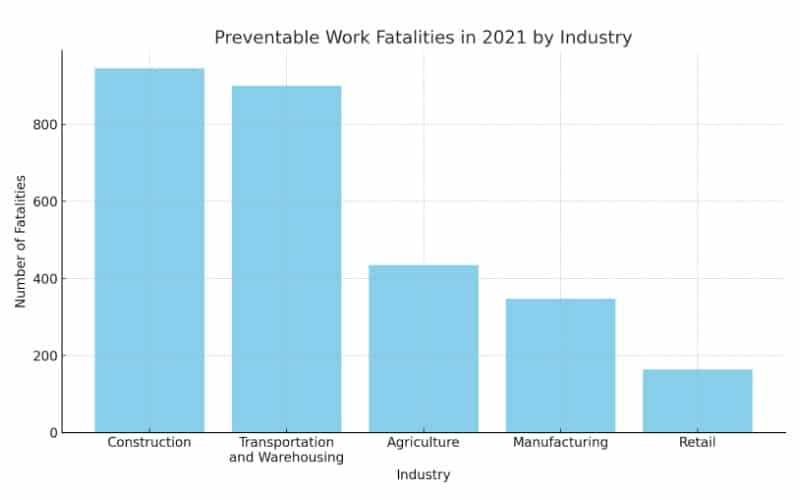
The Impact of Lack of Training on Denver Workers & Businesses
How proper training can prevent accidents and propel business success in Colorado
Denver’s booming economy is powered by its diverse business landscape and the skilled workforce that supports it. But amidst this economic vibrancy, there lies a critical challenge facing both businesses and employees alike: a lack of adequate training.
Insufficient training not only hampers employee performance and job satisfaction but also poses significant risks to workplace safety and productivity. This issue has far-reaching consequences, affecting not just the individual workers but also the overall success and reputation of Denver’s businesses.
As we delve into this topic, we’ll explore how the absence of proper training can be a major roadblock to both personal career advancement and business excellence, underscoring the need for comprehensive and continuous skill development in the modern workplace.
Colorado work injury and fatality statistics
According to the Colorado Department of Public Health & Environment (CDPHE), in 2019, there were 23,376 non-fatal work injuries in Colorado. Of those injuries, 5,774 resulted in days away from work, including 4,836 that resulted in more than 10 days away from work.
The CDPHE also reports that an average of 112 Colorado workers die each year from work-related injuries, illnesses or diseases. That equates to about 1 work-related death every 3 to 4 days.
How many work fatalities are preventable?
Every year in the U.S., thousands of workers die from on-the-job injuries, and sadly, the vast majority of these deaths are preventable.
In 2021 alone, the Bureau of Labor Statistics (BLS) reported 5,190 fatal work injuries in the U.S. Of those fatalities, the National Safety Council (NSC) estimates that 4,472 were preventable. That’s an astonishing 86%.
The top 5 U.S. industries with preventable deaths included:
- Construction (946 fatalities)
- Transportation and warehousing (900 fatalities)
- Agriculture (435 fatalities)
- Manufacturing (347 fatalities)
- Retail (164 fatalities)
How important is training to employees?
Training is crucial to both employee safety and the overall productivity of a business because it reduces the risk of injuries and fatalities that lead to costly medical expenses and time away from work. Lack of proper training is a significant factor in work-related accidents, injuries and deaths.
Below are some areas in which a lack of training frequently leads to poor outcomes for workers and employers:
- Safety procedures. Training provides employees with a thorough understanding of safety procedures and protocols. Without this knowledge, workers may not be aware of potential hazards or how to avoid them, leading to accidents.
- Use of equipment. Many work environments involve specialized equipment. Without adequate training, employees may misuse or improperly operate this equipment, increasing the risk of accidents.
- Occupational hazards. Different industries have unique hazards. Regular training is essential in educating employees about these specific risks and the most effective methods to mitigate them.
- Emergency response. Training often includes emergency response procedures. Untrained employees might not know how to react in an emergency, potentially worsening the situation or leading to additional injuries.
- Legal compliance. Many industries have regulatory requirements for employee training. Failure to comply can lead to violations, penalties and an increased risk of workplace incidents.
Ultimately, training is not just a compliance requirement; it’s a fundamental component of workplace safety. Regular training not only reinforces the importance of safety but also promotes a culture where safety is a priority, which can lead to proactive identification and mitigation of risks.
Top 10 Most Dangerous Professions
Learn about the highest-risk jobs for workers in Colorado and across the U.S.
How does training affect employee performance?
Training has additional benefits for employees beyond their immediate safety. In fact, it’s been shown to significantly impact their performance at work in multiple positive ways:
- It enhances employee skills and knowledge, enabling them to perform their tasks more efficiently and effectively. This increase in competence often leads to higher productivity and a better quality of work.
- It boosts employee confidence, as they feel more equipped and competent to handle their job responsibilities. This confidence can lead to more innovative problem-solving and a proactive approach to work.
- It can improve job satisfaction, as employees appreciate the investment in their personal and professional development, leading to increased motivation and engagement in their roles.
Overall, well-trained employees are a valuable asset to any organization, contributing to improved performance, higher morale and, ultimately, the success of the business.
How does investing in employee training help businesses?
Investing in employee training is a strategic move for businesses, especially considering the high costs associated with work-related injuries.
The National Safety Council reported that in 2021, the total cost of work injuries was a staggering $167 billion. This amount includes not only the cost of workers’ compensation benefits for medical expenses and wage losses but also indirect costs such as administrative expenses and the value of lost productivity.
Moreover, time lost due to work-related injuries is another significant factor. In 2021, a total of 103 million days were lost due to injuries, impacting both current and future productivity.
These figures highlight the immense financial impact of workplace injuries on businesses. By investing in thorough and regular employee training, companies can reduce the incidence of workplace injuries, thereby lowering these substantial costs.
What are the most common reasons why companies do not train employees?
The most common reasons why companies don’t provide adequate training for their employees often involve a combination of perceived cost concerns, underestimation of the benefits, and logistical challenges:
- Cost concerns. Many businesses view training as an expensive endeavor. They focus on the immediate costs of training programs, such as hiring trainers, procuring materials and potentially losing productive work hours during training sessions. This short-term perspective can overshadow the long-term benefits of reduced workplace injuries, increased efficiency and improved employee retention.
- Underestimation of benefits. Some companies underestimate the value that training can bring. They may not recognize how training can enhance employee skills, increase productivity, reduce the risk of costly errors or accidents, and improve overall job satisfaction and morale.
- Logistical challenges. Organizing training sessions can be logistically complex, especially for businesses with multiple locations or those that operate around the clock. Working around scheduling conflicts, finding suitable training facilities, and coordinating with external trainers can be daunting tasks for any organization.
- Lack of customized training resources. Generic training programs may not meet the specific needs of a company or its industry. Developing customized training resources can be time-consuming and costly, and some companies may not have the expertise or resources to do so effectively.
- Inadequate support from management. Without strong backing and commitment from top management, training initiatives may not receive the necessary resources or attention. This lack of support can stem from a failure to see training as a strategic investment.
- Overemphasis on on-the-job training. Some companies rely heavily on informal, on-the-job training, believing it to be sufficient. While on-the-job training is valuable, it can miss critical elements that structured training programs provide, such as standardized procedures and compliance with legal requirements.
- Perceived lack of immediate impact. Training results may not be immediately visible, leading some companies to question its effectiveness. The long-term benefits, while significant, might not be apparent in the short term, leading to a preference for more immediate, tangible investments.
Addressing these issues requires a shift in mindset to view employee training as a necessary investment that yields significant long-term benefits, both in terms of employee well-being and the company’s overall success and sustainability.
How to Report a Work-Related Injury or Condition
Learn about reporting requirements and timelines after a work injury in Colorado.
How often does OSHA require employees to be trained?
The Occupational Safety and Health Administration (OSHA) mandates that employees receive training at least once a year. This means retraining should occur within a 365-day period, not necessarily on the exact anniversary of the previous training.
The timing can be adjusted slightly for convenience in scheduling, but it should be close to the one-year mark. In cases where training can’t be completed by the anniversary date, employers are required to keep a record explaining the delay and specifying when the training will be conducted.
With that being said, some situations require more frequent training. For example, it’s crucial that employees receive prompt training to protect themselves from any new hazards that emerge due to changes in workplace practices, procedures or tasks.
Additionally, if an employee’s performance indicates a lack of understanding or incomplete training, more frequent retraining may be necessary to ensure complete comprehension and safety.
Were you injured at work in Denver? Babcock Tucker can help.
At Babcock Tucker, we recognize the crucial role of employee training in ensuring a safe work environment for Colorado’s diverse workforce. If you’ve been injured on the job due to inadequate training or other workplace hazards, we’re here to assist you.
Our knowledgeable Denver work injury attorneys understand the complexities of workers’ compensation claims and are dedicated to helping you navigate the legal process with ease and confidence. Let us advocate for your rights and work tirelessly to secure the compensation and benefits you deserve.
Contact us today for a free, comprehensive evaluation of your case and personalized legal guidance.
References
Acceptable time lapse for “annual” training. | Occupational Safety and Health Administration. (n.d.). www.osha.gov. https://www.osha.gov/laws-regs/standardinterpretations/2007-01-24#:~:text=However%2C%20wherever%20OSHA%20standards%20require
Indicator 1_non-fatal work-related injuries.pdf. (n.d.). Google Docs. Retrieved December 1, 2023, from https://drive.google.com/file/d/1eo0GZcDdwOPOaMCLFISOiVlDUKDlY41x/view
National Safety Council. (2018). Work Injury Costs – Injury Facts. Injury Facts. https://injuryfacts.nsc.org/work/costs/work-injury-costs/
Work Safety Introduction – Injury Facts. (2017). Injury Facts. https://injuryfacts.nsc.org/work/work-overview/work-safety-introduction/
Workplace safety data and reports | Department of Public Health & Environment. (n.d.). cdphe.colorado.gov. https://cdphe.colorado.gov/workplace-safety/workplace-safety-data-and-reports
Workplace safety surveillance reports | Department of Public Health & Environment. (n.d.). cdphe.colorado.gov. Retrieved December 1, 2023, from https://cdphe.colorado.gov/workplace-safety/data-and-reports/workplace-safety-surveillance-reports







